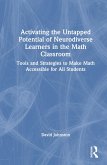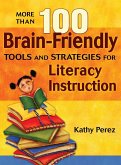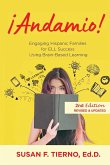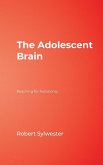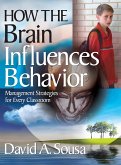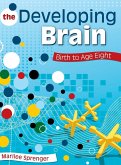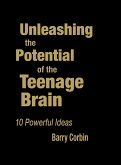Michael A. Scaddan
40 Engaging Brain-Based Tools for the Classroom
Michael A. Scaddan
40 Engaging Brain-Based Tools for the Classroom
- Gebundenes Buch
- Merkliste
- Auf die Merkliste
- Bewerten Bewerten
- Teilen
- Produkt teilen
- Produkterinnerung
- Produkterinnerung
This guide converts current findings on brain research into fun and effective techniques for introducing brain-compatible learning and improving test results in the K-12 classroom.
Andere Kunden interessierten sich auch für
![Activating the Untapped Potential of Neurodiverse Learners in the Math Classroom Activating the Untapped Potential of Neurodiverse Learners in the Math Classroom]() David JohnstonActivating the Untapped Potential of Neurodiverse Learners in the Math Classroom200,99 €
David JohnstonActivating the Untapped Potential of Neurodiverse Learners in the Math Classroom200,99 €![More Than 100 Brain-Friendly Tools and Strategies for Literacy Instruction More Than 100 Brain-Friendly Tools and Strategies for Literacy Instruction]() Kathy PerezMore Than 100 Brain-Friendly Tools and Strategies for Literacy Instruction81,99 €
Kathy PerezMore Than 100 Brain-Friendly Tools and Strategies for Literacy Instruction81,99 €![Andamio! Engaging Hispanic Families for ELL Success Using Brain-Based Learning Andamio! Engaging Hispanic Families for ELL Success Using Brain-Based Learning]() Susan TiernoAndamio! Engaging Hispanic Families for ELL Success Using Brain-Based Learning24,99 €
Susan TiernoAndamio! Engaging Hispanic Families for ELL Success Using Brain-Based Learning24,99 €![The Adolescent Brain The Adolescent Brain]() Robert SylwesterThe Adolescent Brain82,99 €
Robert SylwesterThe Adolescent Brain82,99 €![How the Brain Influences Behavior How the Brain Influences Behavior]() David A. SousaHow the Brain Influences Behavior101,99 €
David A. SousaHow the Brain Influences Behavior101,99 €![The Developing Brain The Developing Brain]() Marilee SprengerThe Developing Brain81,99 €
Marilee SprengerThe Developing Brain81,99 €![Unleashing the Potential of the Teenage Brain Unleashing the Potential of the Teenage Brain]() Barry CorbinUnleashing the Potential of the Teenage Brain71,99 €
Barry CorbinUnleashing the Potential of the Teenage Brain71,99 €-
-
-
This guide converts current findings on brain research into fun and effective techniques for introducing brain-compatible learning and improving test results in the K-12 classroom.
Hinweis: Dieser Artikel kann nur an eine deutsche Lieferadresse ausgeliefert werden.
Hinweis: Dieser Artikel kann nur an eine deutsche Lieferadresse ausgeliefert werden.
Produktdetails
- Produktdetails
- Verlag: Corwin
- Seitenzahl: 144
- Erscheinungstermin: 23. Oktober 2008
- Englisch
- Abmessung: 286mm x 221mm x 13mm
- Gewicht: 641g
- ISBN-13: 9781412949132
- ISBN-10: 1412949130
- Artikelnr.: 25329360
- Herstellerkennzeichnung
- Produktsicherheitsverantwortliche/r
- Europaallee 1
- 36244 Bad Hersfeld
- gpsr@libri.de
- Verlag: Corwin
- Seitenzahl: 144
- Erscheinungstermin: 23. Oktober 2008
- Englisch
- Abmessung: 286mm x 221mm x 13mm
- Gewicht: 641g
- ISBN-13: 9781412949132
- ISBN-10: 1412949130
- Artikelnr.: 25329360
- Herstellerkennzeichnung
- Produktsicherheitsverantwortliche/r
- Europaallee 1
- 36244 Bad Hersfeld
- gpsr@libri.de
Michael A. Scaddan is an international educational consultant who works in the USA, Australasia, Asia, and Europe. He is the author of 40 Engaging Brain-Based Tools for the Classroom as well as 24 training manuals and 3 educational DVDs. He has a background in elementary and adult teaching as well as being a highly successful principal and was recently selected as patron for The Hungarian Brain Based Institute. As a school principal, he continued to be a practical, hands-on educator, teaching all levels of children through an innovative Learn to Learn program. This enabled him to develop hundreds of useful and practical classroom tips as well as fine-tune successful schoolwide techniques that are now passed on to fellow educators. Always looking for a better way, he has extensive training in brain-compatible learning, completing an MEd in accelerated learning at the University of Tasmania. Scaddan is now CEO of Brain Stems Ltd., a brain-compatible training organization, and has worked as a full-time learning consultant in the USA, Sweden, Hungary, India, and Australia, as well as throughout New Zealand. He has recently been employed as an educational consultant to the government of Thailand.
Acknowledgments
About the Author
Introduction
Part I. Enhancing Relationships
1. Emotional Learning
2. Metaphors
3. Rules or Agreements
4. Choice
5. Anti-Stress Techniques
Review
6. Put Ups
7. Breathing Techniques
8. Relaxation
9. Eliminating Extrinsic Rewards
10. Punishment and Consequences
Review
Part II. Developing Patterns and Coherence
11. Contamination
12. Concentration
13. State Changes
14. Cross Overs
Review
15. Improving Memory Links
16. Memory Techniques
17. Rough Draft
18. Elaboration
19. Repetition
20. Themes
Review
Part III. Promoting Understanding: A Model for a "Learn to Learn" Framework
21. Input-Learning Styles
22. Learning Preferences
23. Multiple Intelligences
Review
24. Motivators
25. Four Great Questions
26. WIIFM
27. Pulling Your Own Strings
28. Goal Setting
29. Myfirmations
30. Overviews
Review
Academic Data
Part IV. Putting It All Together
31. Framing
32. Pre-wiring
33. Loops
34. Feedback
35. Mind Maps and Mindscapes
36. Reflection
37. Lo, Mo, Ho
38. Inclusive Statements
39. Response Time
Something to Aim for
40. Hands Free: An Expectation to Answer
Conclusion
Suggested Reading
References
Index
About the Author
Introduction
Part I. Enhancing Relationships
1. Emotional Learning
2. Metaphors
3. Rules or Agreements
4. Choice
5. Anti-Stress Techniques
Review
6. Put Ups
7. Breathing Techniques
8. Relaxation
9. Eliminating Extrinsic Rewards
10. Punishment and Consequences
Review
Part II. Developing Patterns and Coherence
11. Contamination
12. Concentration
13. State Changes
14. Cross Overs
Review
15. Improving Memory Links
16. Memory Techniques
17. Rough Draft
18. Elaboration
19. Repetition
20. Themes
Review
Part III. Promoting Understanding: A Model for a "Learn to Learn" Framework
21. Input-Learning Styles
22. Learning Preferences
23. Multiple Intelligences
Review
24. Motivators
25. Four Great Questions
26. WIIFM
27. Pulling Your Own Strings
28. Goal Setting
29. Myfirmations
30. Overviews
Review
Academic Data
Part IV. Putting It All Together
31. Framing
32. Pre-wiring
33. Loops
34. Feedback
35. Mind Maps and Mindscapes
36. Reflection
37. Lo, Mo, Ho
38. Inclusive Statements
39. Response Time
Something to Aim for
40. Hands Free: An Expectation to Answer
Conclusion
Suggested Reading
References
Index
Acknowledgments
About the Author
Introduction
Part I. Enhancing Relationships
1. Emotional Learning
2. Metaphors
3. Rules or Agreements
4. Choice
5. Anti-Stress Techniques
Review
6. Put Ups
7. Breathing Techniques
8. Relaxation
9. Eliminating Extrinsic Rewards
10. Punishment and Consequences
Review
Part II. Developing Patterns and Coherence
11. Contamination
12. Concentration
13. State Changes
14. Cross Overs
Review
15. Improving Memory Links
16. Memory Techniques
17. Rough Draft
18. Elaboration
19. Repetition
20. Themes
Review
Part III. Promoting Understanding: A Model for a "Learn to Learn" Framework
21. Input-Learning Styles
22. Learning Preferences
23. Multiple Intelligences
Review
24. Motivators
25. Four Great Questions
26. WIIFM
27. Pulling Your Own Strings
28. Goal Setting
29. Myfirmations
30. Overviews
Review
Academic Data
Part IV. Putting It All Together
31. Framing
32. Pre-wiring
33. Loops
34. Feedback
35. Mind Maps and Mindscapes
36. Reflection
37. Lo, Mo, Ho
38. Inclusive Statements
39. Response Time
Something to Aim for
40. Hands Free: An Expectation to Answer
Conclusion
Suggested Reading
References
Index
About the Author
Introduction
Part I. Enhancing Relationships
1. Emotional Learning
2. Metaphors
3. Rules or Agreements
4. Choice
5. Anti-Stress Techniques
Review
6. Put Ups
7. Breathing Techniques
8. Relaxation
9. Eliminating Extrinsic Rewards
10. Punishment and Consequences
Review
Part II. Developing Patterns and Coherence
11. Contamination
12. Concentration
13. State Changes
14. Cross Overs
Review
15. Improving Memory Links
16. Memory Techniques
17. Rough Draft
18. Elaboration
19. Repetition
20. Themes
Review
Part III. Promoting Understanding: A Model for a "Learn to Learn" Framework
21. Input-Learning Styles
22. Learning Preferences
23. Multiple Intelligences
Review
24. Motivators
25. Four Great Questions
26. WIIFM
27. Pulling Your Own Strings
28. Goal Setting
29. Myfirmations
30. Overviews
Review
Academic Data
Part IV. Putting It All Together
31. Framing
32. Pre-wiring
33. Loops
34. Feedback
35. Mind Maps and Mindscapes
36. Reflection
37. Lo, Mo, Ho
38. Inclusive Statements
39. Response Time
Something to Aim for
40. Hands Free: An Expectation to Answer
Conclusion
Suggested Reading
References
Index


